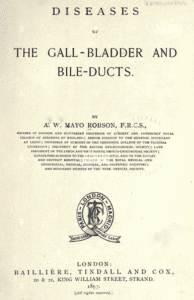JMS Pearce
Hull, England, United Kingdom

Arthur William Robson (1853–1933) (Fig 1) was born the son of a chemist John Bonnington Robson, in Filey, a popular Yorkshire seaside resort.1 He later added Mayo to his surname. He is reported as attending Wesley College in Sheffield, though he is not mentioned in their list of alumni. He read medicine at the Leeds School of Medicine, where he was an outstanding student and won prizes in medicine, surgery, midwifery, materia medica, anatomy, and physiology.2 He graduated in 1870. In 1874, he passed the Member of the Royal College of Surgeons (MRCS) qualifying examination and five years later the Fellowship (FRCS).
In 1876 he lectured in anatomy at Leeds in 1876, and a surgeon at the Leeds General Infirmary (LGI) in 1884.1 Lord Moynihan (1865–1936), who had been his house-surgeon, noted: “When the Board of the Infirmary decided to appoint two assistant surgeons to relieve the surgeons of some of their increasing duties, McGill and Mayo-Robson were elected. I should doubt whether any hospital has ever appointed on the same day, two men who could be considered their equal.”3 He became Professor of Surgery at Leeds in 1890.
Leeds was already a center with a famous surgical tradition, which he enhanced by his scientific progressive operative methods.2 He stimulated younger surgeons including Berkeley Moynihan, who succeeded him to the Chair at Leeds and became President of the Royal College of Surgeons. Mayo-Robson at first confined himself to gynecology, but soon turned his eager mind and manual dexterity to other problems. His abdominal work was inspired by Lawson Tait, who followed Spencer Wells, another Leeds student. His groundbreaking work on the gall bladder began in 1884 and was quickly followed by surgery of the stomach, intestines, and pancreas.

He rapidly became a recognized pioneer in surgery of the pancreas and bile ducts (Fig 2). He had visited Lister in Edinburgh, and successfully employed his aseptic techniques.3 His patients were anaesthetized, probably with nitrous oxide and ether inhalation using the Clover apparatus developed in 1876.
These were major advances of the time, which reduced surgical morbidity and mortality.
Mayo-Robson was “a sturdy man, spectacled, bearded, and good-looking, and was endowed with health and vitality.”2 He was widely known for his enthusiasm, infinite capacity for taking pains, his knowledge of other authorities, and his surgical skills that Moynihan described: “Hands magical in their suppleness, gentleness, uncanny dexterity.”2,3
A versatile and adventurous operator, in addition to abdominal surgery, he performed removal of knee cartilages in 1902, before orthopedics became a specialty, and described the surgery of urethral stricture by rapid dilatation with Lister’s graduated sounds. He reported his successful surgery of both cranial and spinal meningoceles in 1895, and in 1889 the first successful nerve graft to the median nerve that had been resected for a tumor in a fourteen-year-old girl, effected by grafting two and a half inches of the posterior tibial nerve from an amputated leg.4 He later performed this procedure on limbs paralyzed by gunshot wounds. In 1890 he recorded in the British Medical Journal tapping and draining the cerebral ventricles in cases of hydrocephalus and meningitis.
Mayo-Robson was three times Hunterian professor of surgery at the Royal College of Surgeons, twice its vice-president, and in 1904 a Bradshaw lecturer on cancer and its treatment.2 From 1890 to 1899, he was Professor of Surgery at Yorkshire College, the predecessor of the University of Leeds.3,5 During World War I he served in France, Turkey, and Egypt with the rank of temporary Colonel, Army Medical Service.1 He published several books, all greatly admired. (Table 1)
| Table 1. Mayo-Robson’s books2 |
| 1. On gall-stones and treatment 1892 2. Meningocele treated by plastic operation 1895 3. Diseases of the gall-bladder and ducts 1897 4. Diseases of the stomach and their surgical treatment with Moynihan 1901 6. Diseases of the pancreas and their surgical treatment with Moynihan 1902 7. The pancreas, its surgery and pathology with Cammidge 1907 8. Gall-stones, their complications and treatment with PJ Cammidge 1909 |
After World War 1, aged sixty-five, Mayo-Robson returned to London. He served as a member of the medical council at the War Office, and as consulting surgeon to King Edward VII Hospital at Windsor and the Dreadnought Hospital at Greenwich.2
He was knighted (KB) in 1908, honored as Companion of the Royal Victorian Order in 1911, Companion of the Order of the Bath in 1916, and KBE in 1919.5,1 He settled in Seale, Surrey after the war.
He married Florence, the daughter of William Walker of Leeds, in 1883.1 They had three daughters. After Florence’s death, he remarried in 1932. He remembered several medical charities in his will, including £1,000 to the LGI for an annual prize in surgery.2
In his eulogy, Lord Moynihan wrote:
As I look back dispassionately upon the growth of the science and art of surgery in the last fifty years, I can truthfully say that Mayo-Robson must rank among the very greatest surgeons of all time.3
References
- Arthur Mayo-Robson. Wikipedia. https://en.wikipedia.org/wiki/Arthur_Mayo-Robson
- Sir Arthur Mayo-Robson, K.B.E., C.B., C.V.O., F.R.C.S. Ann R Coll Surg Engl. 1952; 11(5): 330–332.
- Lord Moynihan. Sir Arthur Mayo-Robson, K.B.E., CGB. D.Sc., F.R.CS. Appreciation Br Med J. 1933;2(3798):761–762.
- Mayo-Robson AW. Nerve grafting as a means of restoring function in limbs paralysed by gunshot or other injuries. Br Med J. 1917;1(2926):117–118.
- Mayo-Robson, Sir Arthur William (1853 – 1933). Plarr’s Lives of the Fellows. The Royal College of Surgeons of England. Created 21 November 2013.
JMS PEARCE is a retired neurologist and author with a particular interest in the history of medicine and science.

Leave a Reply